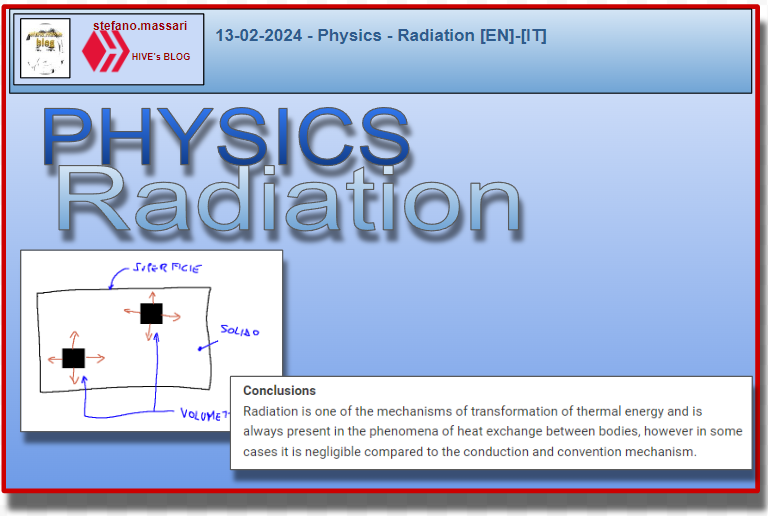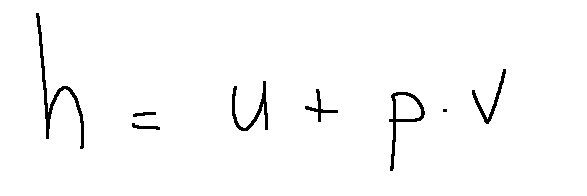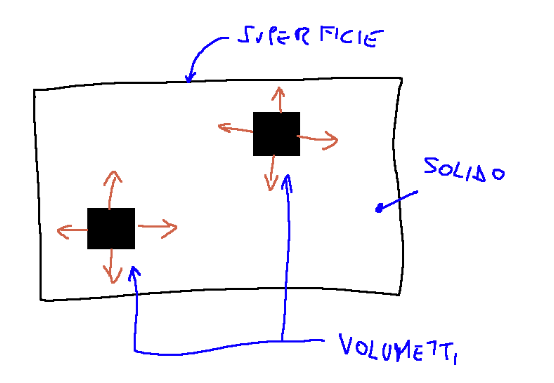
~~~ La versione in italiano inizia subito dopo la versione in inglese ~~~
ENGLISH
13-02-2024 - Physics - Radiation [EN]-[IT]
Basic concepts
Enthalpy is a state function, it is usually possessed by a thermodynamic system and is indicated with the letter H. Enthalpy is defined as the sum of internal energy (U) plus the product of pressure and volume.

Where:
h = enthalpy
u = internal energy
p = pressure
v = volume
When we talk about enthalpy we should also mention the Gibbs equations.
With the Gibbs equations it is possible to calculate the entropy variation through integration, provided that the functional relations between the quantities appearing in the second members are known.
The radiation
There are three main thermal energy transfer mechanisms:
-conduction
-convection
-radiation
Radiation is always present in the phenomena of thermal exchange between bodies, however, sometimes compared to the mechanisms of conduction and convection, this can be negligible.
Let us now consider the figure below.

If we consider this figure we can say that each small volume, those represented by the black squares, emits thermal radiation in any direction.
This means that it is not just the surface that emits thermal radiation, essentially the whole body emits heat.
Thermal radiation propagates even in the absence of an intervening medium, which however cannot happen with conduction and convection.
Thermal radiation is a type of radiation and is that emitted by temperature.
Thermal energy is the form of energy possessed by any body that has a temperature higher than 0°K (-273.15 °C), i.e. absolute zero.
Thermal energy is an extensive quantity.
Conclusions
Radiation is one of the mechanisms of transformation of thermal energy and is always present in the phenomena of heat exchange between bodies, however in some cases it is negligible compared to the conduction and convention mechanism.
Request
Radiation, for example, is the mechanism by which the energy emitted by the Sun reaches and heats the Earth. Do you know other examples?

13-02-2024 - Fisica - L'irraggiamento [EN]-[IT]
Concetti base
L'entalpia è una funzione di stato, solitamente è posseduta da un sistema termodinamico e viene indicata con la lettera H. L'Entalpia è definita come la somma dell'energia interna (U) più il prodotto tra la pressione ed il volume.

Dove:
h = entalpia
u = energia interna
p = pressione
v = volume
Quando si parla di entalpia è il caso di nominare anche le equazioni di Gibbs.
Con le equazioni di Gibbs si può calcolare la variazione di entropia tramite integrazione, a patto di conoscere le relazioni funzionali tra le grandezze che compaiono nei secondi membri.
L'irraggiamento
I principali meccanismi di trasferimento dell’energia termica sono tre:
-conduzione
-convezione
-irraggiamento
L'irraggiamento è sempre presente nei fenomeni di scambi termici tra corpi, tuttavia, alcune volte rispetto ai meccanismi di conduzione e convezione, questo può essere trascurabile.
Prendiamo ora in considerazione la figura qui sotto riportata.

Se consideriamo questa figura possiamo dire che ogni volumetto, quelli rappresentati dai quadrati neri, emette radiazioni termiche in qualsiasi direzione.
Questo significa che non è solo la superficie ad emettere radiazioni termiche, sostanzialmente tutto il corpo è emettitore di calore.
L'irraggiamento termico si propaga anche in assenza di mezzo interposto, cosa che invece non può avvenire con la conduzione e la convezione.
La radiazione termica è un tipo di irraggiamento ed è quella emessa dalla temperatura.
L’energia termica è la forma di energia posseduta da qualsiasi corpo che abbia una temperatura superiore a 0°K ( -273,15 °C), cioè allo zero assoluto.
L’energia termica è una grandezza estensiva.
Conclusioni
L'irraggiamento è uno dei meccanismi di trasformazione dell'energia termica ed è sempre presente nei fenomeni di scambi termici tra corpi, però in alcuni casi risulta trascurabile rispetto al meccanismo di conduzione e di convenzione.
Domanda
L’irraggiamento, per esempio, è il meccanismo mediante il quale l’energia emessa dal Sole raggiunge e riscalda la Terra. Conoscete altri esempi?
THE END